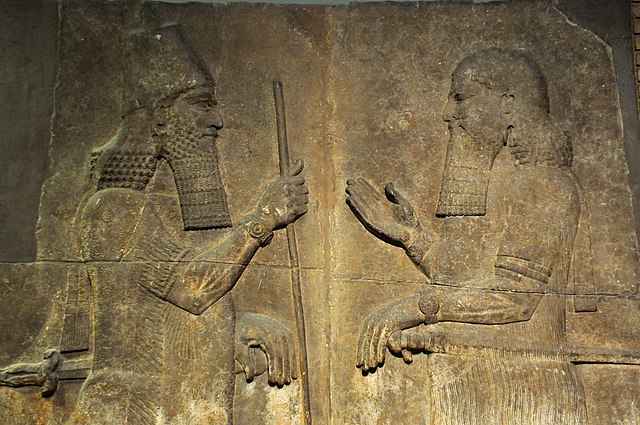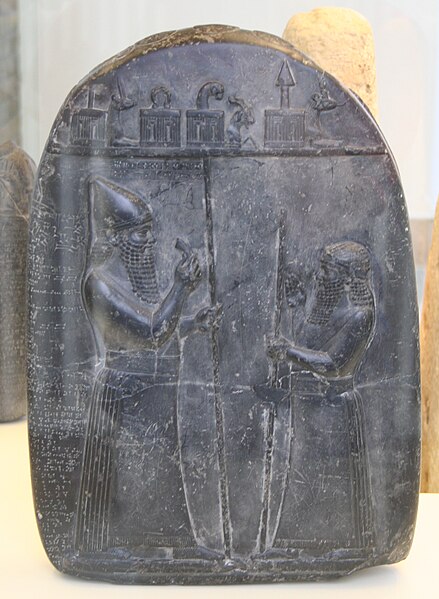Sennacherib was the king of the Neo-Assyrian Empire from the death of his father Sargon II in 705 BC to his own death in 681 BC. The second king of the Sargonid dynasty, Sennacherib is one of the most famous Assyrian kings for the role he plays in the Hebrew Bible, which describes his campaign in the Levant. Other events of his reign include his destruction of the city of Babylon in 689 BC and his renovation and expansion of the last great Assyrian capital, Nineveh.
Cast of a rock relief of Sennacherib from the foot of Mount Judi, near Cizre
Alabaster bas-relief depicting Sargon II, Sennacherib's father and predecessor
Sennacherib's father Sargon II (left) facing a high-ranking official, possibly his crown prince Sennacherib
Depiction of Sennacherib's arch-enemy Marduk-apla-iddina II (left), king of Babylon 722–710 BC and 704/703–703 BC and the instigator of many of Sennacherib's later conflicts
Sin or Suen (Akkadian: 𒀭𒂗𒍪, dEN.ZU) also known as Nanna (Sumerian: 𒀭𒋀𒆠 DŠEŠ.KI, DNANNA) was the Mesopotamian god representing the moon. While these two names originate in two different languages, respectively Akkadian and Sumerian, they were already used interchangeably to refer to one deity in the Early Dynastic period. They were sometimes combined into the double name Nanna-Suen. A third well attested name is Dilimbabbar (𒀭𒀸𒁽𒌓). Additionally, the moon god could be represented by logograms reflecting his lunar character, such as d30 (𒀭𒌍), referring to days in the lunar month or dU4.SAKAR (𒀭𒌓𒊬), derived from a term referring to the crescent. In addition to his astral role, Sin was also closely associated with cattle herding. Furthermore, there is some evidence that he could serve as a judge of the dead in the underworld. A distinct tradition in which he was regarded either as a god of equal status as the usual heads of the Mesopotamian pantheon, Enlil and Anu, or as a king of the gods in his own right, is also attested, though it only had limited recognition. In Mesopotamian art, his symbol was the crescent. When depicted anthropomorphically, he typically either wore headwear decorated with it or held a staff topped with it, though on kudurru the crescent alone served as a representation of him. He was also associated with boats.

Impression of the cylinder seal of Ḫašḫamer, ensi (governor) of Iškun-Sin c. 2100 BCE. The seated figure is probably king Ur-Nammu, bestowing the governorship on Ḫašḫamer, who is led before him by Lamma (protective goddess). Sin himself is indicated in the form of a crescent.
Symbols representing Sin (center), Ishtar (left) and Shamash (right), as depicted on the upper half of a kudurru of Meli-Shipak II.
A relief of Kušuḫ (right), the Hurrian moon god, from Yazılıkaya
A relief depicting the offering of a libation to the Anatolian moon god Arma (right).








